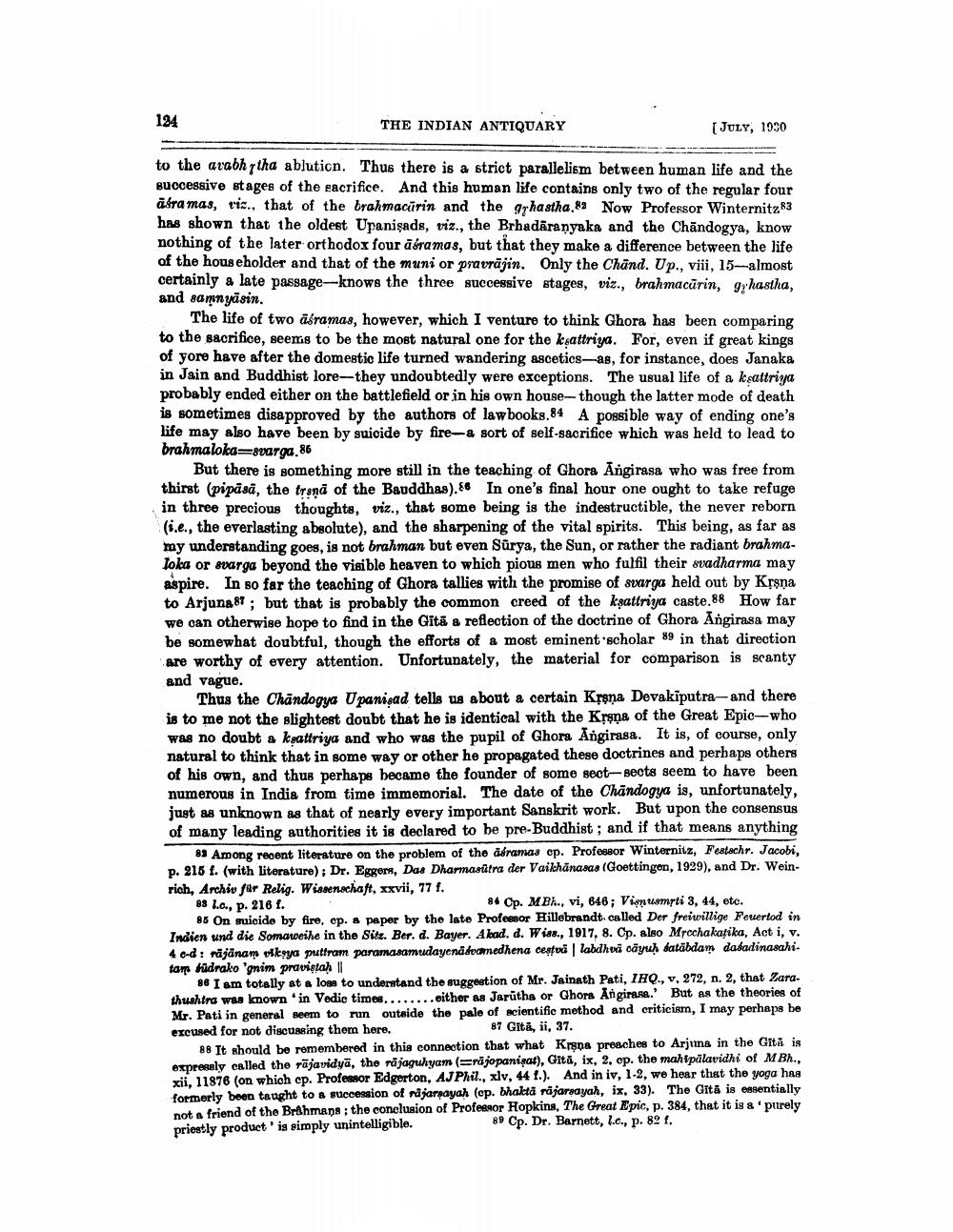________________
184
THE INDIAN ANTIQUARY
[JULY, 1930
to the arabh tha ablution. Thus there is a strict parallelism between human life and the successive stages of the sacrifice. And this human life contains only two of the regular four afra mas, riz., that of the brahmacurin and the grhastha.89 Now Professor Winternitz83 has shown that the oldest Upanişads, viz., the Brhadāranyaka and the Chandogya, know nothing of the later orthodox four ābramas, but that they make a difference between the life of the householder and that of the muni or pravräjin. Only the Chand. Up., viii, 15-almost certainly a late passage-knows the three successive stages, viz., brahmacūrin, grhastha, and samnyāsin.
The life of two āframas, however, which I venture to think Ghora has been comparing to the sacrifice, seems to be the most natural one for the ksattriya. For, even if great kings of yore have after the domestic life turned wandering ascetics-ag, for instance, does Janaka in Jain and Buddhist lore--they undoubtedly were exceptions. The usual life of a ksattriya probably ended either on the battlefield or in his own house-though the latter mode of death is sometimes disapproved by the authors of lawbooks.84 A possible way of ending one's life may also have been by suicide by fire-a sort of self-sacrifice which was held to lead to brahmaloka=svarga.86
But there is something more still in the teaching of Ghora Angirasa who was free from thirst (pipāsā, the trend of the Bauddhas).&6 In one's final hour one ought to take refuge in three precious thoughts, viz., that some being is the indestructible, the never reborn (i.e., the everlasting absolute), and the sharpening of the vital spirits. This being, as far as my understanding goes, is not brahman but even Sürya, the Sun, or rather the radiant brahmaloka or svarga beyond the visible heaven to which pious men who fulfil their svadharma may aspire. In so far the teaching of Ghora tallies with the promise of svarga held out by Krsna to Arjuna 87 ; but that is probably the common creed of the kşattriya caste.88 How far we can otherwise hope to find in the Gită a reflection of the doctrine of Ghora Angirasa may be somewhat doubtful, though the efforts of a most eminent scholar 89 in that direction are worthy of every attention. Unfortunately, the material for comparison is scanty and vague.
Thus the Chandogya Upanigad tells us about a certain Krana Devakiputra- and there is to me not the slightest doubt that he is identical with the Krşna of the Great Epic-who was no doubt a koattriya and who was the pupil of Ghora Angirasa. It is, of course, only natural to think that in some way or other he propagated these doctrines and perhaps others of his own, and thus perhaps became the founder of some sect-sects seem to have been numerous in India from time immemorial. The date of the Chandogya is, unfortunately, just as unknown as that of nearly every important Sanskrit work. But upon the consensus of many leading authorities it is declared to be pre-Buddhist ; and if that means anything
83 Among recent literature on the problem of the asramas cp. Professor Winternitz, Festschr. Jacobi, p. 215 f. (with literature); Dr. Eggers, Das Dharmasūtra der Vaikhănasas (Goettingen, 1929), and Dr. Weinrich, Archiv får Relig. Wissenschaft, xxvii, 77 f. 88 Lc., p. 216 f.
84 Op. MB., vi, 146; Vion usmrti 3, 44, etc. 85 On suicide by fire, op. a paper by the late Professor Hillebrandt. called Der freiwillige Feueriod in Indien und die Somaweihe in the Sitz. Ber. d. Bayer. Abad. d. Wiss., 1917, 8. Cp. also Mrochakatika, Act i, v. 40-d: näjänam vikoya puttram paramasamudayenā svomedhena centua labdhvi cāyuh databdan dasadinasahitam hüdrakognim pravistahl
88 I am totally at a loss to understand the suggestion of Mr. Jainath Pati, IHQ., v, 272, n. 2, that Zara. thushtra was known in Vedic times........either as Jarutha or Ghora Angiras.' But as the theories of Mr. Pati in general seem to run outside the pale of scientific method and criticism, I may perhaps be excused for not discussing them here.
87 Gita, ii, 37. 88 It should be remembered in this connection that what Krsna presches to Arjuna in the Gita is expressly called the rajavidyā, the ndjaguhyam (=rijopanipat), Gita, ix, 2. op. the mahtpalavidhi of MBh.. xii, 11876 (on which op. Professor Edgerton, AJ Phil., xlv, 44 f.). And in iv, 1-2, we hear that the yoga has formerly been taught to a succession of nijar ayah (cp. bhakta räjarsayah, ix, 33). The Gita is essentially not a friend of the Brahmans; the conclusion of Professor Hopkins, The Great pic, p. 384, that it is a purely priestly product is simply unintelligible.
89 Cp. Dr. Barnett, 1.c., p. 82 f.




